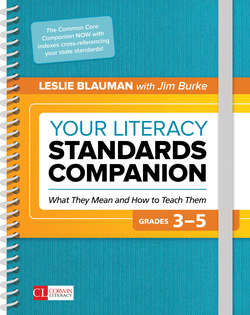Читать книгу Your Literacy Standards Companion, Grades 3-5 - Leslie Blauman - Страница 42
На сайте Литреса книга снята с продажи.
Common Core Reading Standard 3: What the Teacher Does
ОглавлениеTo describe in depth characters, settings, or events in a story:
As you read aloud books, get students to notice how the character drives the plot. Teach students to hit the pause button at major shifts in setting/scene, time periods, and chapter endings and ask themselves, What does the author want me to notice as new here? How is this helping—or hindering—the character resolve the problem she is trying to solve?
Have students make a list of all the characters in a story, and chart what they’re like (both externally and internally) and what causes them to be that way/feel that way. Discuss that characters, just like people in real life, have contradictory aspects of their personality.
Create class charts depicting the sequence of important events, and then have students work in groups to consider an event from each character’s POV.
Build a plot map—individually, in groups, or as a class—noting specific events in a story.
Think aloud how you would use the specific details to describe in detail the characters, settings, or events. Model orally and also in written form for the students.
Have students write in-depth descriptions of characters, setting, or events from the text using specific details.
To explain how actions contribute to the sequence of events:
Create a graphic chart or plot diagram and ask students to analyze the plot for moments when characters do something that affects the plot—increases tension, causes change—in a measurable, discernable way. Sometimes called a “fever chart” to represent the rising and falling action of events in the story.
To compare/contrast two or more characters, settings, or events in a story or drama, and to explain the relationships or interactions between two or more individuals, events, procedures, ideas, or concepts:
Have students identify the wants or needs of key characters and parts of the story where their different wants and needs conflict.
Have students create graphic organizers (Venn diagrams, two-column notes, double-bubble Thinking Maps) to record information about what is similar and different about characters and their families, their communities, and their beliefs. Look at settings and major events through the same bifocals: What might the author want us to notice through these sharp contrasts?
Model how to write a comparison piece and then model how to write contrast using graphic organizers. Co-construct a comparison/contrast piece with students using a shared text.
Help students determine why something happened as it did. This will help them begin to identify cause and effect relationships between concepts, people, and events in informational texts.
Gather a few texts (informational) that each offer a different and clear example of signal words. Read the texts and chart the signal words (timelines, dates, numbered steps, and words like first, second, next, last, most importantly, and years ago).
To draw from specific details and key details in the text and to summarize:
Model summarizing the text by thinking aloud and using specific words, phrases, and sentences.
Have students write their own summaries, highlighting where they have used specific text details.
To use language that pertains to time, sequence, and cause/effect:
Using a shared text, model how to discern if the text is organized in time, sequence, or cause/effect. Highlight key terms in the text and discuss how these are specific to that technique.
Create a chart of key language that lets students know that two pieces of information, ideas, concepts, or events are being compared (e.g., but, however, in contrast).
Teach students how to use highlighting or color-coding to identify and delineate the different key language.
To explain events, scientific ideas, or concepts or steps in technical procedures in a text:
Using a shared text, model how to determine key words that are important to the main idea of the text.
Think aloud to demonstrate how to take these key details and formulate “what happened.” Create graphic organizers (e.g., cause/effect charts) to demonstrate the “why” of what happened.
To help your English language learners, try this:
Guide a small group of students through a text and discuss setting and characters. Students should each have their own copy of the book or text. Help students use vocabulary to describe and explain. Provide students with graphic organizers. Talk thorough the task first, then fill in the organizers with labels and pictures.
For graphic organizer templates, see online resources at resources.corwin.com/literacycompanion3-5.
